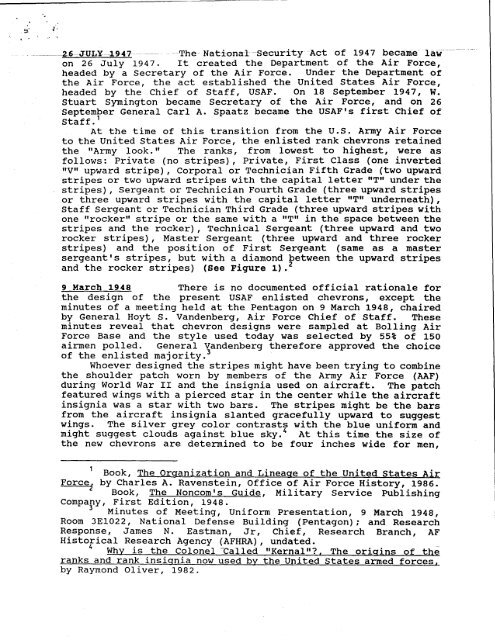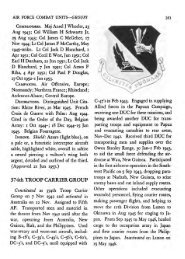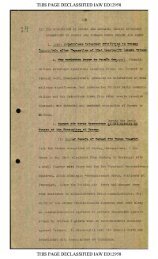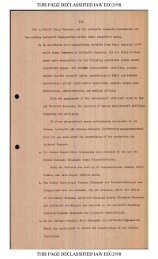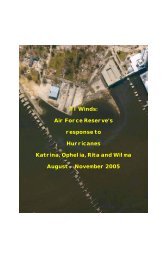A Chronology Of The Enlisted Rank Chevron Of - Air Force Historical ...
A Chronology Of The Enlisted Rank Chevron Of - Air Force Historical ...
A Chronology Of The Enlisted Rank Chevron Of - Air Force Historical ...
Create successful ePaper yourself
Turn your PDF publications into a flip-book with our unique Google optimized e-Paper software.
2 6 JULY 19 7 - - <strong>The</strong>- National Security Act of 1947 became law<br />
on 26 July 1947 . It created the Department of the <strong>Air</strong> <strong>Force</strong>,<br />
headed by a Secretary of the <strong>Air</strong> <strong>Force</strong> . Under the Department of<br />
the <strong>Air</strong> <strong>Force</strong>, the act established the United States <strong>Air</strong> <strong>Force</strong>,<br />
headed by the Chief of Staff, USAF . On 18 September 1947, W .<br />
Stuart Symington became Secretary of the <strong>Air</strong> <strong>Force</strong>, and on 26<br />
September General Carl A . Spaatz became the USAF's first Chief of<br />
Staff .<br />
At the time of this transition from the U .S . Army <strong>Air</strong> <strong>Force</strong><br />
to the United States <strong>Air</strong> <strong>Force</strong>, the enlisted rank chevrons retained<br />
the "Army look ." <strong>The</strong> ranks, from lowest to highest, were as<br />
follows : Private (no stripes), Private, First Class (one inverted<br />
"V" upward stripe), Corporal or Technician Fifth Grade (two upward<br />
stripes or two upward stripes with the capital letter "T" under the<br />
stripes), Sergeant or Technician Fourth Grade (three upward stripes<br />
or three upward stripes with the capital letter "T" underneath),<br />
Staff Sergeant or Technician Third Grade (three upward stripes with<br />
one "rocker" stripe or the same with a "T" in the space between the<br />
stripes and the rocker), Technical Sergeant (three upward and two<br />
rocker stripes), Master Sergeant (three upward and three rocker<br />
stripes) and the position of First Sergeant (same as a master<br />
sergeant's stripes, but with a diamond between the upward stripes<br />
and the rocker stripes) (See Figure 1) .<br />
9 March 1948 <strong>The</strong>re is no documented official rationale for<br />
the design of the present USAF enlisted chevrons, except the<br />
minutes of a meeting held at the Pentagon on 9 March 1948, chaired<br />
by General Hoyt S . Vandenberg, <strong>Air</strong> <strong>Force</strong> Chief of Staff . <strong>The</strong>se<br />
minutes reveal that chevron designs were sampled at Bolling <strong>Air</strong><br />
<strong>Force</strong> Base and the style used today was selected by 55% of 150<br />
airmen polled . General 3andenberg therefore approved the choice<br />
of the enlisted majority .<br />
Whoever designed the stripes might have been trying to combine<br />
the shoulder patch worn by members of the Army <strong>Air</strong> <strong>Force</strong> (AAF)<br />
during World War II and the insignia used on aircraft . <strong>The</strong> patch<br />
featured wings with a pierced star in the center while the aircraft<br />
insignia was a star with two bars . <strong>The</strong> stripes might be the bars<br />
from the aircraft insignia slanted gracefully upward to suggest<br />
wings . <strong>The</strong> silver grey color contrasts with the blue uniform and<br />
might suggest clouds against blue sky . 4 At this time the size of<br />
the new chevrons are determined to be four inches wide for men,<br />
Book, <strong>The</strong> Organization and Lineage of the United States <strong>Air</strong><br />
<strong>Force</strong> by Charles A . Ravenstein, <strong>Of</strong>fice of <strong>Air</strong> <strong>Force</strong> History, 1986 .<br />
Book, <strong>The</strong> Noncom's Guide , Military Service Publishing<br />
Company, First Edition, 1948 .<br />
Minutes of Meeting, Uniform Presentation, 9 March 1948,<br />
Room 3E1022, National Defense Building (Pentagon) ; and Research<br />
Response, James N . Eastman, Jr, Chief, Research Branch, AF<br />
<strong>Historical</strong> Research Agency (AFHRA), undated .<br />
Why is the Colonel Called "Kernal"? . <strong>The</strong> origins of the<br />
ranks and rank insignia now used by the United States armed forces<br />
by Raymond Oliver, 1982 .


